Curated by Waldemar Tatarczuk, who has four of the European Performance art Festivals in Warsaw under his belt, the festival promoted a younger generation. Tatarczuk asked three established artists, Janusz Baldyga from Poland, Boris Nieslony from Germany, and Alastair MacLennan from Northern Ireland, to select a group each.
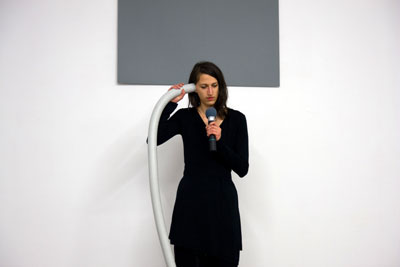
The Polish group performed on Friday; it included Myroslaw Wayda (1977) from Ukraine, and Przemyslaw Przepiora (1979), Marta Bosowska (1984), Kamil Wnuk (1980) and Janusz Baldyga (1983) from Poland. Elisa Andessner (1983) from Austria ‘opened’ the festival by a simple set-up called Otwarta – Polish for ‘open’. In a reminder of childhood play, Andessner stood at the central wall, one end of a ribbed plastic tube at her ear. The other end was spoken into by Tatarczuk standing at the opposite wall. Word after word, she misunderstood, mispronounced or both, what he said. An audio-visual irony targeted the loss of meaning in transmission, and habitually unsatisfactory opening speeches. In a playful rehearsal of Wittgenstein’s idea that we are trapped by language and reduced to playing language games, the pertinence of the difference between correct and incorrect, between knowing and not, between a norm and a variation, became irrelevant.
Two days later, she sparkled in a duet with Boris Nieslony.
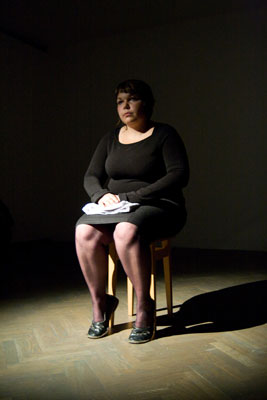
Stripping simplicity to its bare elegance straight in the first minute of the performance called Untouchable, Marta Bosowska harnessed generic multiplicity by evoking the correlation between a taboo and curiosity. Dressed in black, she sat on a chair in a circular spotlight, with a neatly folded spotless white cloth on her lap, both hands resting on top. With effortless precision in timing, the unfolding and folding of the cloth intensified every time she fumbled inside the half-unfolded cloth to take something out and put it into her mouth. I became convinced that she took nothing out, and chewed nothing until a tiny brown fragment got caught in a corner of her mouth. At the end she turned her back to the audience, knelt at the chair, and unfolded the cloth containing a heap of hair, some mixed up with saliva. The audience moved forward to see what the secret substance was; some experienced moderate revulsion.
The public was to go through another, more explicit, trial in Invitation by Kamil Wnuk. He stood in the dark corner next to a screen onto which he projected three slides one after the other with texts: “I invite a master Janusz Baldyga." Nothing happened. Then he projected “I invite a master Alastair MacLennan"; again nobody turned up. Next Wnuk projected “I invite a master Boris Neislony" – no response either.

After several repeats and no action, he moved to the edge of the screen, becoming more visible, and repeated the invitations. In response, Janusz Baldyga stepped forward and stood in the opposite corner. On the screen an image appeared of Wnuk’s undressed body whose digitally altered arms looked like those of an embryo. Wnuk moved towards Baldyga, took off his jacket and with a carpet stapler attached it over the projected image. The same procedure was repeated for MacLennan and Nielsony. All three masters stood there politely, as if in mutual agreement. Afterwards, with the exception of Baldyga, they denied any previous agreement with the artist. If so, Wnuk ran the risk that the invited men would not respond. As it happened, their curiosity, loyalty or trust allowed them to follow Baldyga’s example.
Covering up the naked body resonates with Catholic belief and works as a metaphor for ‘clothing’ a vulnerable emerging artist with some values held by his elders. Next, with paranoid haste, Wnuk started taking off clothes from randomly selected members of the audience. Some silently accepted his aggression, some quickly left the room to avoid him. When he attempted to disrobe a female member of the audience, her firm and loud “NO" sounded far too many times. Wnuk turned the invitation into a coercion. Eventually, two men from the audience attacked him, taking off his T-shirt and holding him firmly down.
A dark side of participation turned a brilliant performance into an abject one, forging conflict, spite and hostility. Running a work of art so near the edge that is defined by bad acts of people in all parts of the world condemns the art to illustrate life, to illustrate the relationship between an aggressor and the victim.
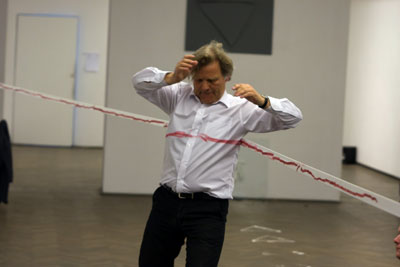
The above artists, with the exception of Andessner, were selected by Janusz Baldyga (1954). He himself delivered Double triangle performance that included his hallmarks: geometry, marked spaces and scrolling. The first ‘marked space’ was formed by triangles on paper fixed on the wall and two triangles in white on the wooden floor. The second ‘marked space’ was formed by a circle of small drinking glasses. The third ‘marked space’ was separated from the rest of the room by a fabric ribbon. Before ‘scrolling’ standing up along the wall, Baldyga moved while sitting on a chair, jerkily, and marked the tape with lipstick. Transfer of a geometric shape or of a mark from one ground to another marks the spaces and constructs signs of ownership: I was here, it was my space for a while. Installation, drawing and performance jelled seamlessly into an encounter with a desire to imprint presence in some physical trace. It reminds me of Sartre’s Being and nothingness – its classical existentialist imagery of presence. When one transfer overlaps with another a transformation occurs, eg two triangles make up a David’s star, the lipstick travels from the pocket to the wall…
Saturday was the day for the group from Northern Ireland: Alastair MacLennan chose Birgit Salling Hansen (1960), Colm Clarke (1983), Stephen Dorothy (1981), Hugh O’Donnell (1978) and Leo Devlin (1983).

Alastair MacLennan (1943) started his Fact (F) Act durational performance early in the rainy morning with the assistance of technical staff of the gallery. They built a heap of rubbish around the seated man according to his instructions. At the end, only his face wearing a mask was visible. Motionless, mostly with eyes closed, he appeared like an object, a wax figurine up to the neck in the detritus of contemporary consumption.
The rain added shine to the plastic, especially when the sun came out later. The wind, hesitantly at first, and then with a drunken abandonment, lifted some pieces, let them limp up and down, before depositing them at the wall, or near a pole, or just between the vegetation. The placement of this work was a result of long consideration. One of the reasons for the choice was his instinct to let nature envelope the art. As it happened, crows came to feed, appropriating the construct.
Depriving oneself of freedom to escape worked as a synecdoche for choking the oceans and land with rubbish and poisons. MacLennan works with a directness and imagistic precision worthy of Ezra Pound’s modernist poetry. He indicates this by naming the performance by an adapted epizeuxis, a figure of speech formed by a repeated word.
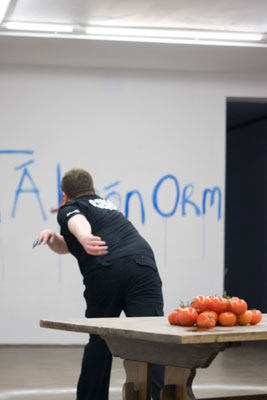

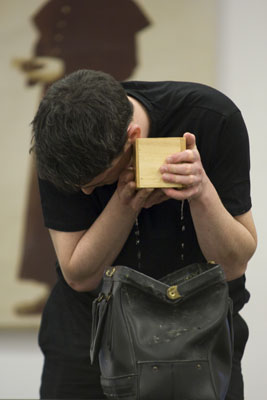
Leo Devlin called his performance Revert (I wish) No, a construct so starched that if you start dismantling it, it will break. Some waiting objects appeared; to call them an installation would do injustice to the languorous confidence with which they harboured their secrets. At one end of the room a black table with a travel bag huddled at an angle to a wall, to which a print of a priest carrying a bible was attached. Further to the middle of the room, an empty chair, a folded umbrella, a gas mask and a fire extinguisher waited their turn. After entering, Devlin purposefully ignored the lot of them. With a twig in one hand he crouched, hovering his contorted body above the floor, intensely looking at the end of the twig while moving slowly backwards, like a giant anthropomorphic lobster. All of his body became one instrument, hauntingly isolating him from all else, focused on searching. At the end of the imagined pathway he turned to the table. From the bag he lifted a wooden cube leaking water profusely and audibly. A satisfaction more appropriate to a lab scientist crossed his face and he returned the box into the bag also filled with water, closing it. The paper print on the wall became the next focus of attention. Devlin lighted its bottom edge, the fire scorched it and died out very quickly. The expected fourth element of the ancient system of being commanded most of the waiting objects. The chair to sit on, the gas mask to put on, the umbrella to open above the head. Alas, the release button on the extinguisher failed at first. Then a white cloud filled the umbrella, enveloping the seated figure.
An ancient myth told in a modern mode intoxicated by the play between opposites. A memorable work.
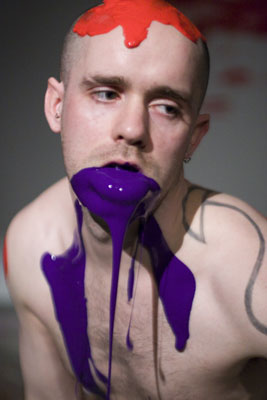
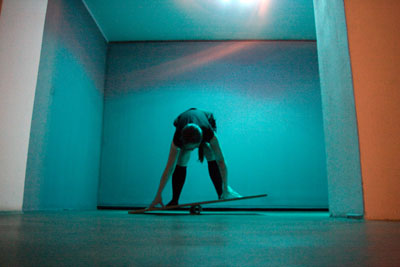
Sunday performances were given by the group selected by Boris Nieslony (1945): Amel Andessner (1983), Elisa Andessner (1983), Sibylle Ettengruber (1976), Nadine Grobels (1985), Sofia Greef (1975) and Kathrin Weber-Krueger (1981).
Amel Andessner sent a twelve-minute video, The Interview with Mirko (2007). Her idea of dressing up as a male fictional character was apparently inspired by two of her personal experiences: meeting a trans-sexual woman and seeing Justin Timberlake dance. A dancer herself, Amel resolved that she could dance as he did, but not as a woman. The dreamy transformatory force of Pygmalion never surfaced from the depth of the possible. At some points, the video looked like an ordinary sleek, accomplished advertisement. The usual negatives and affirmatives of politically correct youth remained unchallenged.
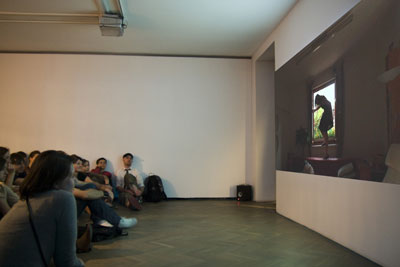
Sibylle Ettengruber became a darling of the Bialystok public, who turned up in unexpectedly large numbers to watch Walk on by –, unfolding the map “2 in which she documented her walk through the city. She started in the street, and followed a straight-line pathway based on a triangle drawn over a map, a site of an old market. She walked through people’s homes, crawled through their windows, climbed over hedges, jumped into a river, marched through undergrowth in the park, walked across a dual carriageway. The camera moved with her, behind her, in front of her, looking at her sideways. A reminder of cinema verité.
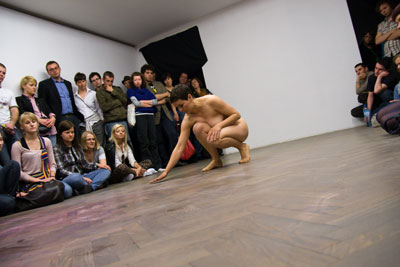
Sofia Greef (1975) gave her performance a Polish name: Dziekuje (‘thank you’), a word she wrote with the palm of her hand on the wooden floor, at the end, with her own urine. How that got there is a part of her concept of her art practice: a fascination with the changes of appearance and the power of a process to unearth “an absurd emergence."
The beginning was equally fascinating: she appeared at the head of the room, naked. Her undressed body, framed by the narrow white wall, instantly evoked association with youth, health, and classical art stripped of symbolism. Governed by a superb harmony of stasis, her body had not moved for a long while, yet the whole meaning shifted. Tiny changes around her mouth – a hesitant smile changed fluently to a full smile and that to a grin as in an imagined conversation. Without any other moves, she directed the scathing grin to the audience gazing at her undressed body. It had the power to evoke embarrassment. Having thus established her supremacy, she proceeded exercising, dancing, jogging, jumping grand jeté, swimming on the wooden floor, both breast and back strokes. She ran around the room, between the people, and ended on one arm supporting her body with feet up the wall.
She evoked fascination and astonishment.
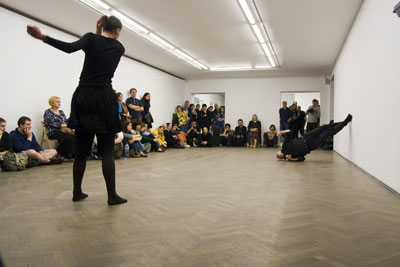
Boris Nieslony invited Elisa Andessner to collaborate on his remarkable performance. Minimal means were worked to their maximum potential in Nature-study: debility – decibel. The set-up was simple: recorded chants gently amplified, as if reaching the level between private and public utterance. Nieslony worked at first slowly at the head of the room, in front of the amplifier; then he moved to a long side wall, changing the speed of action and adding his voice. At the point of change Elisa Andessner entered, positioned herself not quite in the middle of the room and started moving her limbs in silence.
The two performers had not interacted with one another on the level of the senses, but there was an unnameable relation between their behaviour. Andessner held a graceful, poised and seamless dynamics coming from the shoulder socket in several ballet positions, eg an open fourth facilitated asymmetrical large arm movements and hand movements. Her ability to toggle back and forth between a close-up and a broad view appeared both spontaneous and learned during the years of ballet training. She had all the qualities of a star.
Nieslony masterfully metamorphosed into a mentally challenged being, first by making continuous gentle changes in positioning his hands, fingers, neck and torso, as well as the facial muscles. In an enduring ‘portrait’ his body became a tool of anthropological research – dealing with one of that science’s basic question: how do we behave? Its centre is a ‘portrait’ of an experience: he works the wall, tries to break through, wails at his failure, looks surprised and possessed with extraordinary force. Nieslony’s performance, like the best jazz improvisation, appeared composed and spontaneous at the same time.
When he ‘scrolled’ on the floor – the control of timing and movement became obvious; while working against the wall-standing, he emanated complete abandon to the state of ‘his’ mind. A truly exceptional work.
The festival successfully mapped various preferences, ranging from political and personal narrative to what I call ‘anthropological art’, ie the study of human nature, behaviour, identity. Noticeable links to theatre, ballet, rhythm and musical models were in a supporting role to the visual, thus freeing it from related fashionable ideologies, at least in the majority of cases.
Slavka Sverakova, October 2009